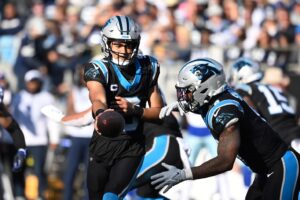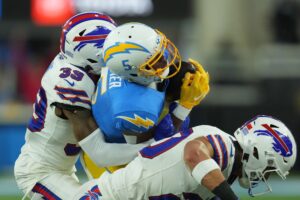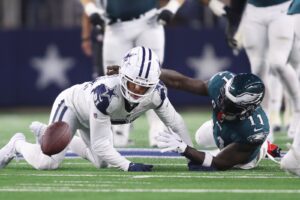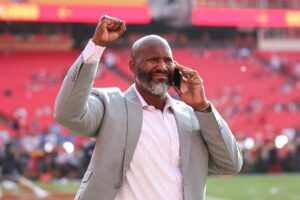The New Orleans Saints entered the 2019 NFL Draft with very little draft currency. When day two of the draft began, New Orleans had yet to select a player and were not slated to make their first pick until late in the second round. All five of their subsequent picks would have taken place in the final three rounds.
Thanks to a couple of trades, the Saints moved up to the 16th slot in the second round and gained an early fourth round pick. Both picks were used on high-grade players who filled positions of need. They also added some promising backups and role players later on. Here’s a full list of the Saints selections:
Second round, 48th overall: Erik McCoy, center, Texas A&M
Fourth round, 105th overall: Chauncey Gardner-Johnson, safety, Florida
Sixth round, 177th overall: Saquan Hampton, safety, Rutgers
Seventh round, 231st overall: Alize Mack, tight end, Notre Dame
Seventh round, 244th overall: Kaden Elliss, linebacker, Idaho
Saints 2019 NFL draft grade: 8.0
New Orleans Saints 2019 NFL Draft Review
The Best Player: Erik McCoy
New Orleans traded up from 62nd to 48th overall to select the last high-grade center in the draft. The Saints had already signed free agent Nick Easton to replace retired Pro Bowl center Max Unger, but Easton lacked consistency with the Minnesota Vikings and wasn’t a satisfying replacement. If McCoy doesn’t win the starting job, he has played a few games at guard and can serve as a solid interior line backup.
McCoy’s value starts with his athletic profile. He ran the fastest 40-time of all the 2019 offensive line prospects and his 29 bench reps tied for seventh-best in the group. He also brings ideal size, with a 6’4″, 303-pound frame and long, well-built arms. McCoy avoided injuries throughout college despite starting all 39 possible contests in his three years at Texas A&M.
In 1,528 pass-blocking snaps, McCoy gave up only one sack, per Pro Football Focus. In 2018 he allowed just seven total quarterback pressures. McCoy and the rest of the Aggies offensive line helped their offense gain over 2,000 rushing yards three years in a row. This run included over 210 rushing yards per game and over 5.3 yards per carry in both 2016 and 2018.
When viewing McCoy’s snaps against a daunting Clemson defensive line (which spawned three 2019 first round picks) last season, it’s difficult to find a bad rep. He also fared well against SEC standouts Quinnen Williams and Jeffery Simmons, who were selected in the first round as well. Centers rarely make for an exciting headlining pick, but McCoy has a great chance to start in New Orleans for years to come.
The Head-Scratcher: No Wide Receiver Selections
When New Orleans traded up to select McCoy, many fans likely expected them to select a wide receiver. The Saints offense did struggle at times last season when opponents zeroed in on Michael Thomas and Alvin Kamara in the passing game. Several quality wide receivers were still available at pick 48, including A.J. Brown, Parris Campbell, and D.K. Metcalf, among others.
However, there are still promising young receivers on the Saints roster, and clearly, the front office is banking on growth from them. This group includes Tre’Quan Smith, their 2018 third round pick, Cameron Meredith, a 2018 free agent who missed all but six games due to injury, and undrafted free agents Keith Kirkwood and Austin Carr. Each showed up sporadically last season, but none consistently averted opponents attention from Thomas.
Despite the underwhelming early returns from this quartet, 2018 was their first full season in the Saints offense and it’s too early to completely rule them out. If some of these receivers can grow during the offseason, the Saints will have sufficient options in the passing game. This offense already got better this offseason with the Jared Cook signing, and New Orleans could still get some production out of veterans Ted Ginn and Dez Bryant.
The Steal: Chauncey Gardner-Johnson
Gardner-Johnson may have been one of the biggest steals of the entire draft. NFL.com projected the Florida safety as a second round pick and gave him the second highest grade at his position.
Gardner-Johnson’s high value comes from his versatility. The bulky 5’11”, 210-pound defender spent time in the slot, in the box, and in single-high coverage. In his three year career, Gardner broke up 12 passes and intercepted nine, three of which he returned for touchdowns. Gardner is also an asset in run support and the pass rush, recording 15.5 tackles and four sacks at Florida.
While Gardner-Johnson has all the tools he needs to succeed in the NFL, he’ll need to improve his instincts to become a respectable starter. New Orleans could be a great place for Gardner-Johnson to blossom. He’s likely to be the third safety on the depth chart, behind Vonn Bell and Marcus Williams, a significant role in a Saints defense that has frequently utilized big nickel formations.
This pick sufficiently satisfied a need at safety, which previously had only special teams contributor Chris Banjo as a third option.
The Surprise: Another Safety?
No one could have predicted that two of the Saints top three picks would be safeties, yet New Orleans selected Rutgers safety Saquan Hampton 72 slots after Gardner-Johnson. In a way though, they did select a different type of player. While Hampton also played a versatile role in college, he’s probably better suited in a traditional strong or deep safety role.
Hampton is also taller and lankier than Gardner-Johnson at 6’1″ and 206-pounds. He ran the same 4.48 40-time and posted a respectable 14 bench reps. If not for two separate shoulder injuries that forced him to miss significant chunks of 2016 and 2017, Hampton would likely have been a higher pick. He came back strong in 2018 though, earning his team’s MVP award along with an All-Big Ten honorable mention.
Last week, I suggested that New Orleans should bolster their secondary on Day three. While their depth now looks stronger at safety and nickel back, they still have a lack of options on the outside if Marshon Lattimore or Eli Apple miss time. Behind them, there’s Ken Crawley and P.J. Williams, who have both had good performances but give up a lot of big plays. Special teams ace Justin Hardee saw some reps at outside corner last season, but he needs to show a lot of progress in training camp to move up the depth chart.
It may sound nit-picky, but if you’re looking for an Achilles-heel on this strong Saints roster, it’s probably a lack of outside cornerback depth.
Most Likely to Turn Heads in Training Camp: Alize Mack
As the first tight end drafted by New Orleans since Jimmy Graham in 2010, Mack will attract immediate attention from a Saints fan base that’s been clamoring for a Graham replacement.
While Mack is a bit shorter and slower than Graham, his game draws some comparisons to the former Saint. Mack was more than just an in-line tight end at Notre Dame. According to Pro Football Focus, he spent significant time lined up as an outside and slot receiver and even had some reps in the backfield. Mack excels at making leaping back-shoulder catches in traffic, a trademark of Graham’s during his Saints tenure.
Like Graham though, Mack has struggled as a run blocker, which will minimize his snaps on the NFL level. Fortunately, Mack won’t step into a big role this year with Cook and Josh Hill firmly ahead of him on the Saints depth chart, so he has time to solidify his game behind the scenes. In 2019, he’ll likely only see the field in special passing packages and on special teams, but he has a high ceiling in the Saints offense.
The Rest
New Orleans rounded out their 2019 draft class with the selection of Kaden Elliss, who spent time at each linebacker spot and defensive end. He’s a raw, small school prospect, but a good fit for New Orleans, which frequently rotated its linebackers last season. In his last two seasons at Idaho, Elliss recorded 32 tackles for losses and 13 sacks. With this knack for getting into the backfield, he may be best utilized as a weakside linebacker who occasionally comes down to the line as an edge rusher.
Bottom Line
Considering how little the Saints had to work with in this draft, they should be happy with how it played out. New Orleans moved up to grab perhaps the second-best center in the second round and snagged a high-graded safety in the fourth round. Their sixth and seventh round selections seem like solid backups with the potential to take on larger roles down the road. For a five-player draft class with just one selection in the first 100 slots, this is as good as it gets.
Another way to look at this draft class is by adding in the players New Orleans acquired with their traded picks. There’s defensive end Marcus Davenport, who became the Saints 2018 first-round selection thanks to a trade that cost them this year’s first-round pick. Last year’s trades for Teddy Bridgewater and Apple cost them their third and fourth-round picks, respectively. If you include these acquisitions, it’s a stellar draft class.
We’ll never know what New Orleans could have gotten from those selections, but it’s clear that all three players will be key Saints components for years to come.
Main photo:
Embed from Getty Images






